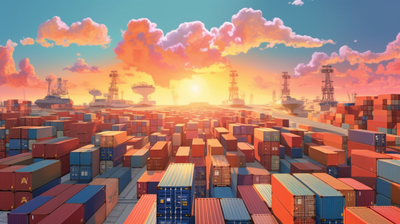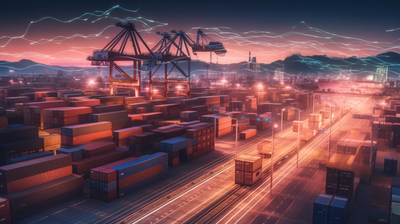Navigating Choices and Transitions: Reflections on Peter Zeihan's Geopolitical Insights
The weight of carbon emissions hangs heavily upon us. We find ourselves amidst a period of profound metamorphosis. As we erect mighty wind towers, we must exercise prudence in their placement, for the winds that sweep through carry with them a vital detail. The immediate impact of these structures on carbon emissions must not be dismissed. Conversely, electric vehicles draw their power from the grid in their present state. However, we must not ignore the substantial carbon cost entailed in the manufacturing process of EVs.
Moreover, it will take over a decade for most vehicles, reliant on existing grids, to offset their carbon debt. Regrettably, information regarding heavier equipment such as semis or forklifts remains elusive, for these products have yet to materialize. Nevertheless, we can speculate that such advancements may require two to three decades to come to fruition. Thus, we are faced with comprehending the implications of these circumstances as we strive to secure our nation's energy resources to sustain our future, all while an unwavering focus on green transition pervades our collective consciousness.

Drawing lessons from the experiences of Europe, we must navigate this intricate terrain with sagacity. The field of material science holds the key to our progress. Before embarking on grand-scale transportation solutions, we must achieve significant breakthroughs in this domain. It is worth noting that the United States boasts the world's preeminent wind zone within the Great Plains. At the same time, the American Southwest, spanning from central California to central Texas, claims the second-best solar area.
Nevertheless, while we should not dismiss these prospects entirely, we must remain aware of the constraints imposed by our limited resources. In this context, it becomes apparent that electric vehicles, in their current manifestation, may not meet the criteria set forth. Assuming their functionality, the immense battery power required for semis presents a formidable challenge that we hope to better understand through the testing of 200,000 units by year-end. However, this endeavour is accompanied by a significant hurdle. It is noteworthy that the issue of inflation remains at the forefront of our concerns, particularly in a world where globalization is undergoing a seismic shift or, perchance, dissolving before our very eyes. Undoubtedly, this bears implications for inflationary trends. Alas, the answer to this predicament may not align with our desires.
We find ourselves at a crossroads where labour pressure permeates every facet of our existence. Chinese and German manufacturers gradually retreated, and access to Russian materials diminished. While the baby boomer generation may be entering retirement, their millennial offspring are entering the zenith of their consumption years, indicating a potential return to the inflationary era that marked the 1970s and 1980s. Furthermore, as we expand our industrial infrastructure, every disinflationary trend witnessed over the past 75 years is now being reversed, replaced by a surge of inflation. These converging factors portend an inflation rate of 9 to 15% for at least five years. This foregone conclusion is inevitably embedded in our reality, irrespective of the actions undertaken by the Federal Reserve. This prognosis arises from a deep understanding of our structural environment.

Looking beyond this five-year horizon, we may transition into a more peaceful state of affairs if we successfully enhance our industrial capacity. Localizing supply chains and revitalizing our manufacturing processes will be pivotal in achieving this desired state. Moreover, our labour metrics will inevitably evolve as we embrace a future in which AI and automation play increasingly prominent roles, particularly in electronics manufacturing. Such a shift will be an unavoidable consequence of the choices we make and the challenges we confront. In this landscape, a clear path lies before us. Failure to traverse this path will perpetuate the wave of inflation, ranging from 9 to 15%, and result in persistent shortages of essential goods. From Peter's vantage point, the choice is stark. The alternative entails enduring the worst of this tumultuous journey without reaping the benefits on the other side.
Understandably, reservations may arise when scrutinizing policymakers' efforts, particularly as they navigate treacherous waters. Jay Powell grapples with the predicament by employing the tools at his disposal. He focuses on regulating demand, aware of the long-term implications of runaway inflation on productive capacity. Yet, ultimately, it is a productive capacity that must be fortified. This predominantly falls within the purview of fiscal policy—a domain that has witnessed the guidance of four US presidents. Among them, Biden emerges as the most pragmatic. While not all his propositions may be unanimously embraced, particularly in energy, his approach exhibits a measure of sensibility.

In conclusion, the choices confronting us in this intricate landscape demand wisdom and discernment. Drawing upon the insights of history and acknowledging the limitations that bind us, we must chart a course forward. The transition towards sustainable energy solutions necessitates scientific breakthroughs, an understanding of our resource limitations, and a holistic approach encompassing the entire industrial ecosystem. Inflation, a pressing concern due to shifting global dynamics, requires proactive measures. Striking a balance in fiscal policy while bolstering productive capacity becomes paramount. The challenges are formidable, yet within them lie opportunities to reshape our world.
Daniel's Take:
- Transitioning to sustainable energy solutions requires mindful consideration of carbon impacts and limitations.
- In their current form, electric vehicles may fall short of meeting the demands of a constrained environment.
- Building industrial infrastructure is essential for a more peaceful future, with localized supply chains and evolved labour metrics.
- Inflationary pressures loom comprehensively, necessitating proactive fiscal policies to maintain productive capacity.
- The challenges present opportunities to reshape our world for a more sustainable and prosperous future.
Cameron's Take:
One of the things that shifted my thinking on these matters is something Professor Scott Galloway said in 2020. He remarked that every problem we thought would happen in 2030 had been pulled forward to today. That was three years ago, and it is clear that the onramp we felt had too many problems facing our global society has arrived on our doorstep now. AI was supposed to be far off, but it is now here. Supply Chain and realignment with China was a distant problem that is not a problem today. Moving away from polluting fossil fuels has been on the agenda, but the technology to begin that transition is becoming evident.
As I've written elsewhere in this series, we have many challenges. There will be progress regarding sustainability, but don't look to eliminate oil and oil products from our lives anytime soon. Getting oil out of transportation is essential, but the pathway to achieving that is still developing. There will be lots of capital required to make this happen. But Dan mentioned that the payoff won't be anytime soon, either.
The inflation piece of this is interesting. I mentioned in this series that Zeihan calls for 15% inflation for the foreseeable as our economy readjusts to domestic and nearby supply chains, which are the increased associated costs accompanying that change. However, I think he's missing a critical piece: the Federal Reserve let the cheap money spigot stay open for about five years longer than it should have. When combined with the lavish spending on the pandemic and the Trump tax cuts, this extra money poured into the economy. Then on top of that, the pandemic has created conditions for new industrialization.
All of these factors contribute to the inflation. Can the Fed solve it? Unlikely and Jerome Powell has admitted as much. They are trying to tamp down inflation, but the reality is that when you're building new facilities and such, money is moving through the economy, demand increases and supply takes time to catch up, causing prices to rise. This demand-pull inflation is impossible to control using monetary policy. The only way to solve it would be to raise taxes, and the Biden administration has taken that step. As it turns out, technology was incredibly deflationary in ways that haven't been understood until now. This means that Volcker and Greenspan's tricks to manage the economy no longer work. The old ways are passing by, and now we are embarking on an entirely new adventure with new things to learn, challenges to confront, and new potential for growth. The solutions for this new economy will not come from the Federal Reserve; they will come from companies and politicians as we decide how to create, manage, and take advantage of the new prosperity from this significant economic change.
The best thing about our present situation is that people are aware of what is happening and looking for it. The "Great Outsourcing" of the late 1990s and early 2000s was diffuse and quiet. It was hardly addressed by the Bush administration, which was too busy with the War on Terrorism. But as companies quietly moved production overseas and hollowed out the Rust Belt of the US, millions were left behind, and no one was willing to address their grievances until the 2016 presidential election when Donald Trump went straight to the heart of the problem. The combination of outsourcing, the opiate crisis, the 2008 crisis, the lack of economic recovery, and the ineptitude of the Obama administration all created the perfect conditions for anger, resentment and electoral backlash. This time, everyone knows what is happening. This presents opportunities for government to do some good by helping create new prosperity and helping real people get into work and have better lives. This must be a component of this new economy, for without it, we will only see more political issues.
Speculating on the Good (καλός) related to this writing:
The contemplation of Peter Zeihan's geopolitical insights, despite the complexity and weight of the issues at hand, presents us with the opportunity to make informed choices and navigate transitions with prudence. By understanding the limitations and potential pitfalls, we can strive for a future that embraces sustainable energy solutions, bolsters productive capacity, and reshapes our world for the betterment of society and the environment. Pursuing wisdom and discernment in the face of daunting challenges promises a more prosperous and harmonious future.






